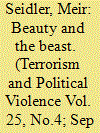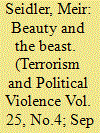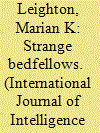|
|
|
Sort Order |
|
|
|
Items / Page
|
|
|
|
|
|
|
| Srl | Item |
| 1 |
ID:
123059


|
|
|
|
|
| Publication |
2013.
|
| Summary/Abstract |
The article deals with the intellectual and philosophical background of Sartre's thought, which made him susceptible to the influence of left-wing totalitarian structures in general and to left-wing terrorism in particular. Consequently it is argued that Sartre's identification with Stalinism in his younger years, and his later sympathies with the infamous German Baader-Meinhof terrorist gang, were more than mere expressions of his personality, but rather part and parcel of his special blend of existentialism and philosophy. At the end of the article, Sartre's position in this matter is contrasted with the position of another existentialist French thinker, Sartre's contemporary, Albert Camus.
|
|
|
|
|
|
|
|
|
|
|
|
|
|
|
|
| 2 |
ID:
124920


|
|
|
|
|
| Publication |
2013.
|
| Summary/Abstract |
The article deals with the intellectual and philosophical background of Sartre's thought, which made him susceptible to the influence of left-wing totalitarian structures in general and to left-wing terrorism in particular. Consequently it is argued that Sartre's identification with Stalinism in his younger years, and his later sympathies with the infamous German Baader-Meinhof terrorist gang, were more than mere expressions of his personality, but rather part and parcel of his special blend of existentialism and philosophy. At the end of the article, Sartre's position in this matter is contrasted with the position of another existentialist French thinker, Sartre's contemporary, Albert Camus.
|
|
|
|
|
|
|
|
|
|
|
|
|
|
|
|
| 3 |
ID:
110004


|
|
|
|
|
| Publication |
2012.
|
| Summary/Abstract |
This article examines the factors that have contributed to the end of the Red Army Faction (RAF), and places particular emphasis on the causes and characteristics of individual disengagement of RAF members from the armed struggle. It discusses the evolution, ideology, and decline of each of the three generations of the RAF. The article's contribution is twofold. First, by assessing both contextual- and individual-level factors that led to the group's demise, the article bridges two approaches to analyzing the demise of terrorist organizations-the literature on how terrorism ends and why individuals disengage from terrorism. Second, the article helps build a growing empirical body of work on the demise of terrorist groups that can be used to confirm, challenge, or refine existing hypotheses on how terrorism ends, while formulating new ones. The article concludes that different factors contributed to the decline of each subsequent generation of the RAF. Successful German police efforts played a critical role in thwarting the RAF's first generation. Lack of public support and recruits, due in large part to an escalation of terrorist violence, hastened the decline of the second generation of the group. The third generation suffered from serious interorganizational strife, exacerbated by a government initiative that offered to release those RAF members from prison who renounced terrorism.
|
|
|
|
|
|
|
|
|
|
|
|
|
|
|
|
| 4 |
ID:
139012


|
|
|
|
|
| Summary/Abstract |
The relationship of the three leftist terrorist organizations in the Federal Republic of Germany to Israel can be summarized, in somewhat abbreviated fashion, as follows: All three groups, the Red Army Faction (Rote Armee Fraktion; RAF), June 2 Movement (Bewegung 2. Juni), and Revolutionary Cells (Revolutionäre Zellen), and the milieu from which they emerged in West Berlin, Munich, Heidelberg, Hamburg, and Frankfurt, hated America, Americans, Israel, and Jews. They participated in the international terror war against Israel and did not shy away from attacks on Jews and Jewish facilities in the Federal Republic of Germany. The three organizations mentioned, for all their differences, are, to be reckoned among the organizations coming out of leftist traditions that, like the Socialist Unity Party of Germany (Sozialistische Einheitspartei Deutschlands), after the end of the Shoah and the Second World War, and in the name of a supposed struggle against fascism, conducted antisemitic propaganda, supported the war of terror against Israel, and publicly justified and supported those groups and institutions working in the same direction.
|
|
|
|
|
|
|
|
|
|
|
|
|
|
|
|
| 5 |
ID:
134895


|
|
|
|
|
| Summary/Abstract |
A massive fortress-like structure dominating Normannenstrasse in East Berlin housed the headquarters of the East German Ministry for State Security (MfS), better known as the Stasi. It was a monument to the tasteless architecture of the Stalinist era. Passersby instinctively recoiled at the sight of the building. They could readily imagine the warren of cellblocks, interrogation rooms, and torture chambers deep inside its walls. Rumor had it that many of the cells were padded with burlap to muffle the screams of the torture victims, as well as to prevent prisoners from committing suicide by banging their heads to a bloody pulp against the concrete walls. The passersby also knew that an overzealous Stasi operative could emerge without warning to arrest and indict them for alleged crimes against the regime. Such “snoop and snatch” tactics were all part of a day's work for the MfS.
|
|
|
|
|
|
|
|
|
|
|
|
|
|
|
|
| 6 |
ID:
175748


|
|
|
|
|
| Summary/Abstract |
Correlations between terrorism and the religious commitments of terrorist organizations and actors have been the subject of extensive scholarly investigation. 1 Whilst the focus has often been on extreme Jihadist terrorism, other terrorist groups and individuals with religious commitments have been widely discussed such as Baruch Goldstein’s 1994 attack in Hebron, Christian Identity groups in the US, and Aum Shinrikyo in Japan. 2 A number of theories have been advanced to explain the relationships between religious commitment and terrorism. For example, Atran has argued that many terrorists are “devoted actors”, and that members of deeply conservative religions are typically devoted actors. 3 Whilst not denying that these factors may be important, this article draws attention to a further significant impact of religion on terrorism: the surprising connection between religion and self-control. 4 Drawing on the large empirical literature establishing a link between religion (in particular deeply conservative religions) and self-control, it is hypothesized that the religious practices of religiously-inspired terrorists enhances their self-control and thus raises their efficacy, operationalized as casualties per attack. This hypothesis will be referred to as TERS (Terrorist Efficacy, Religion and Self-control). TERS predicts that highly conservative religious terrorist groups such as Al Qaeda and ISIS will typically have higher levels of terrorist efficacy than non-religious or moderately religious groups, and the research of supports this hypothesis. 5 In addition, it is argued that TERS provides a crucial addition to Piazza’s emphasis on “universal/abstract” ideologies. 6 Piazza remarks that left-wing terrorist groups can have universal/abstract ideologies. Case studies of atheist left-wing terrorist groups—specifically the Red Army Faction and the Red Brigades—reveal that such groups satisfy Piazza’s characterization of universal/abstract groups but have casualty rates per attack very much lower than those of highly conservative religious groups such as Al Qaeda and its affiliates. It is argued that highly conservative religious convictions enhance the self-control of the latter groups, raising their efficacy relative to the former atheist groups.
|
|
|
|
|
|
|
|
|
|
|
|
|
|
|
|
|
|
|
|
|